Smart RF lensing: efficient, dynamic and mobile wireless power transfer
Sengupta , et al. July 30, 2
U.S. patent number 10,367,380 [Application Number 14/078,489] was granted by the patent office on 2019-07-30 for smart rf lensing: efficient, dynamic and mobile wireless power transfer. This patent grant is currently assigned to CALIFORNIA INSTITUTE OF TECHNOLOGY. The grantee listed for this patent is California Institute of Technology. Invention is credited to Seyed Ali Hajimiri, Kaushik Sengupta.
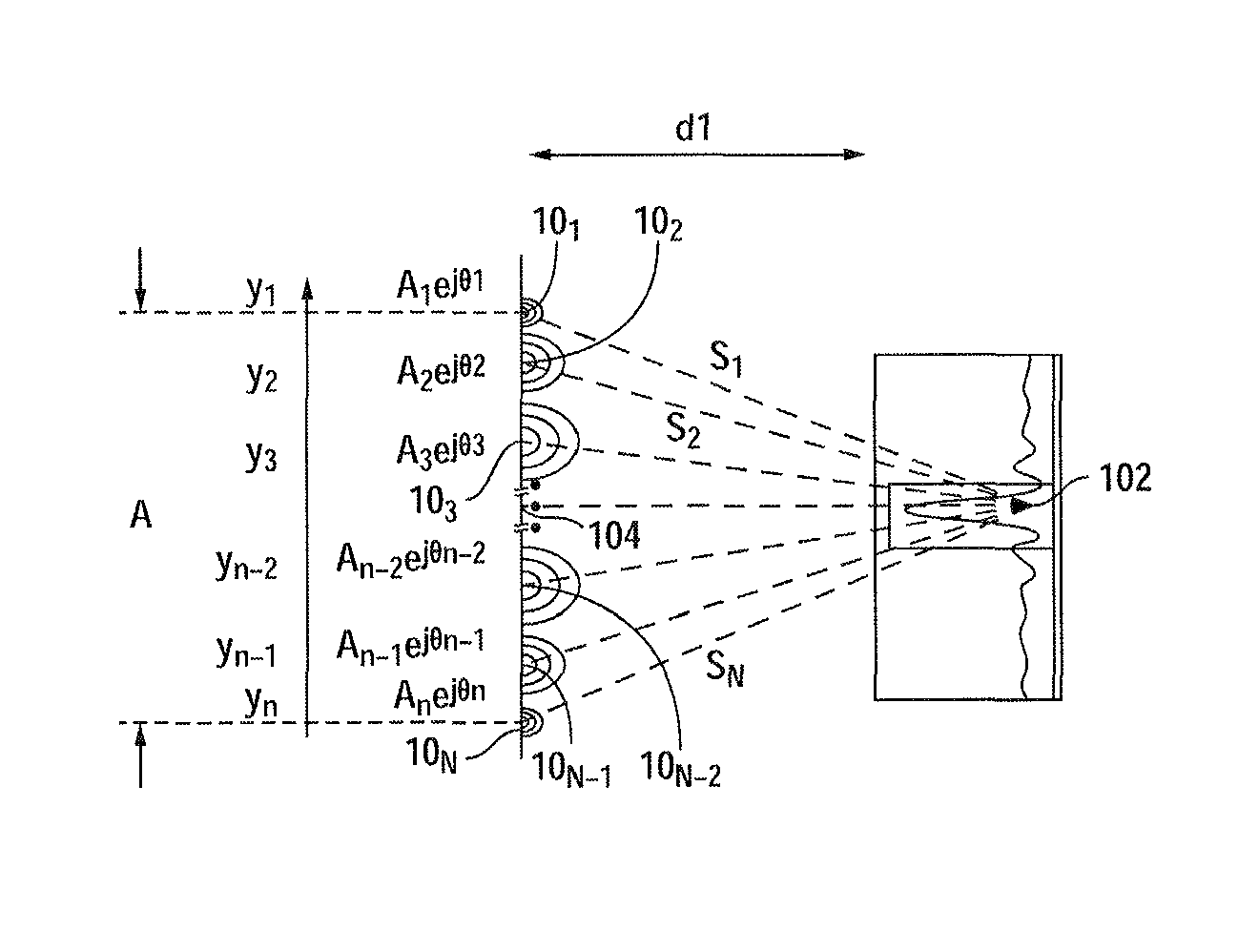

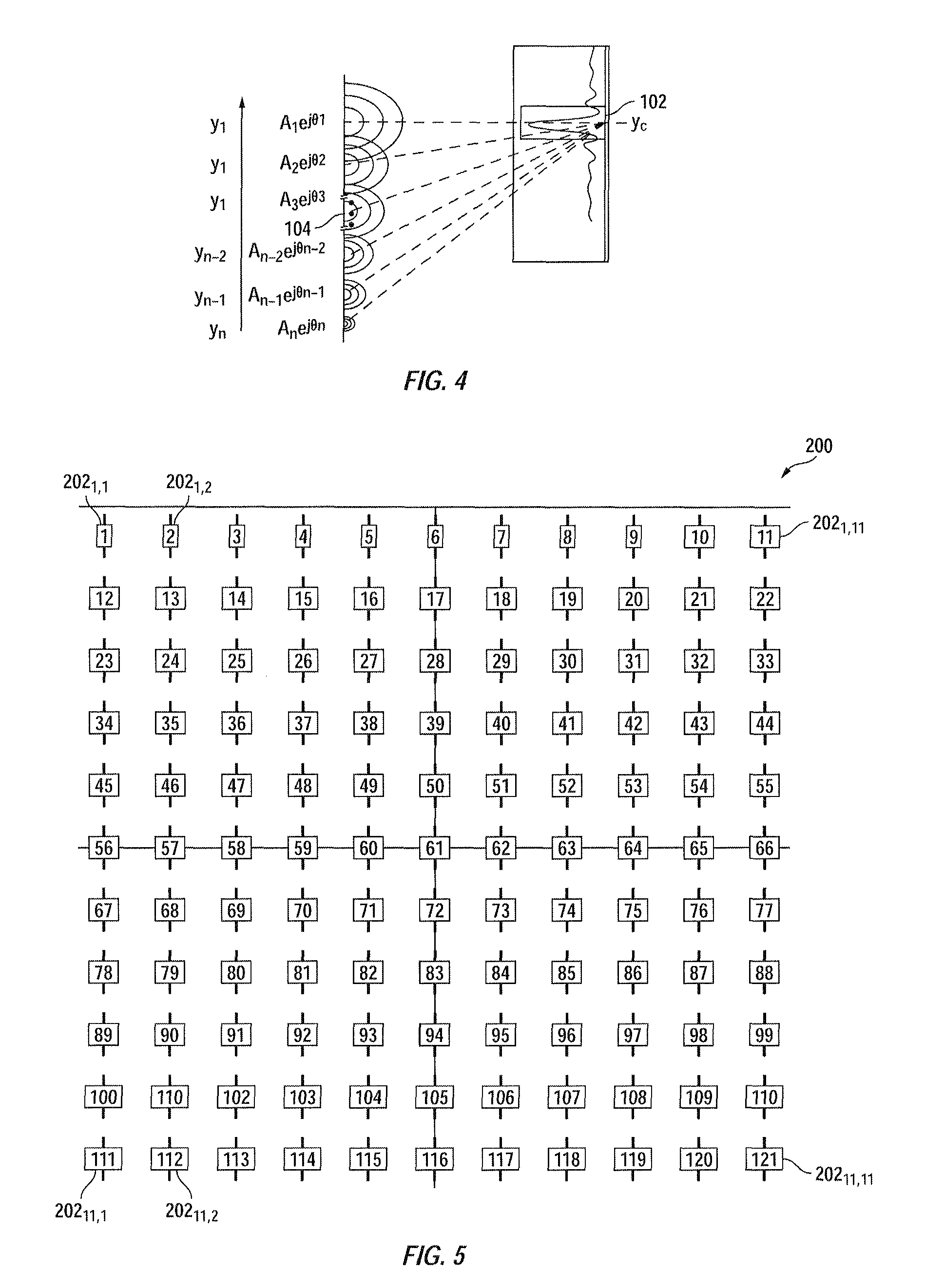


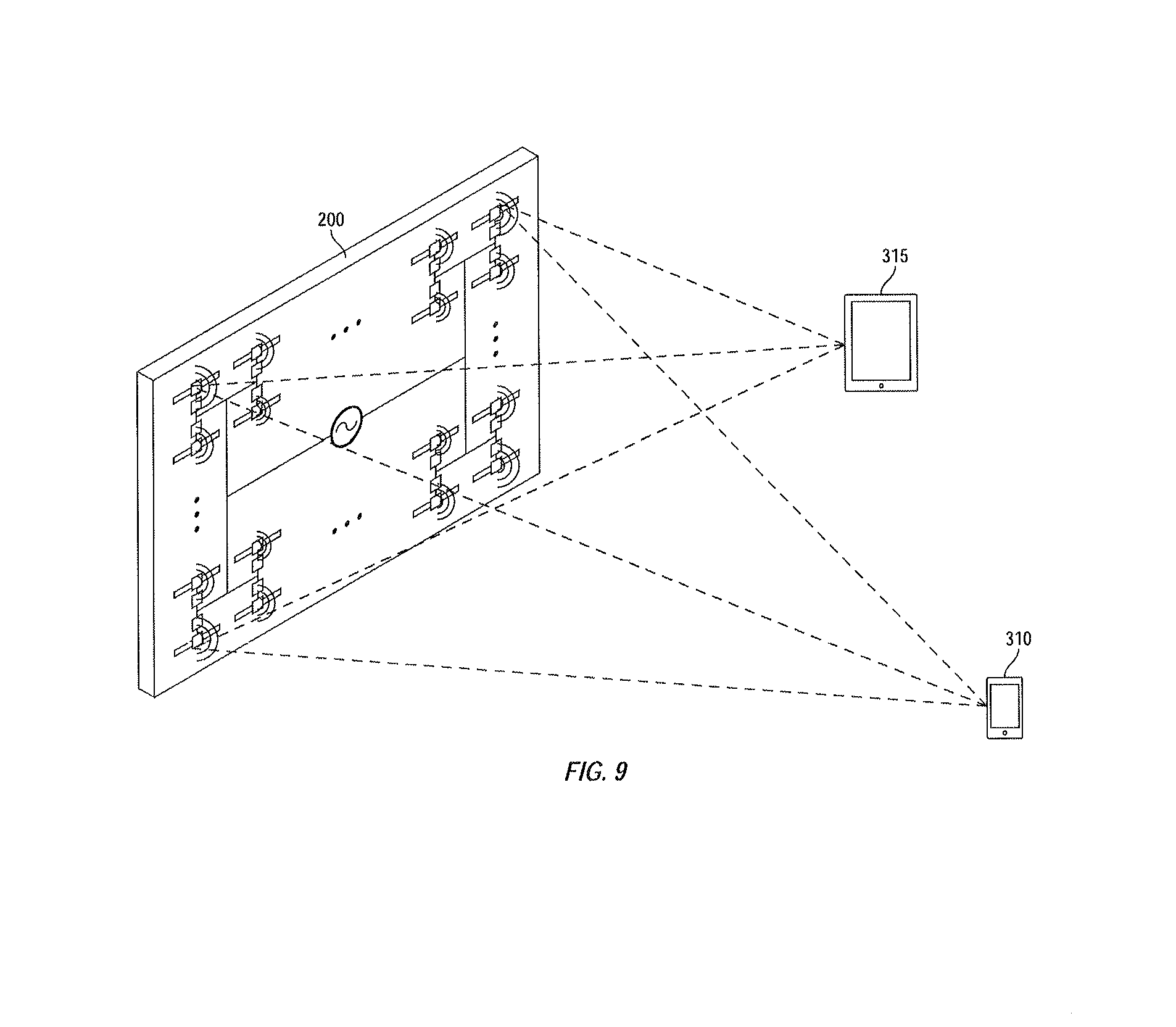
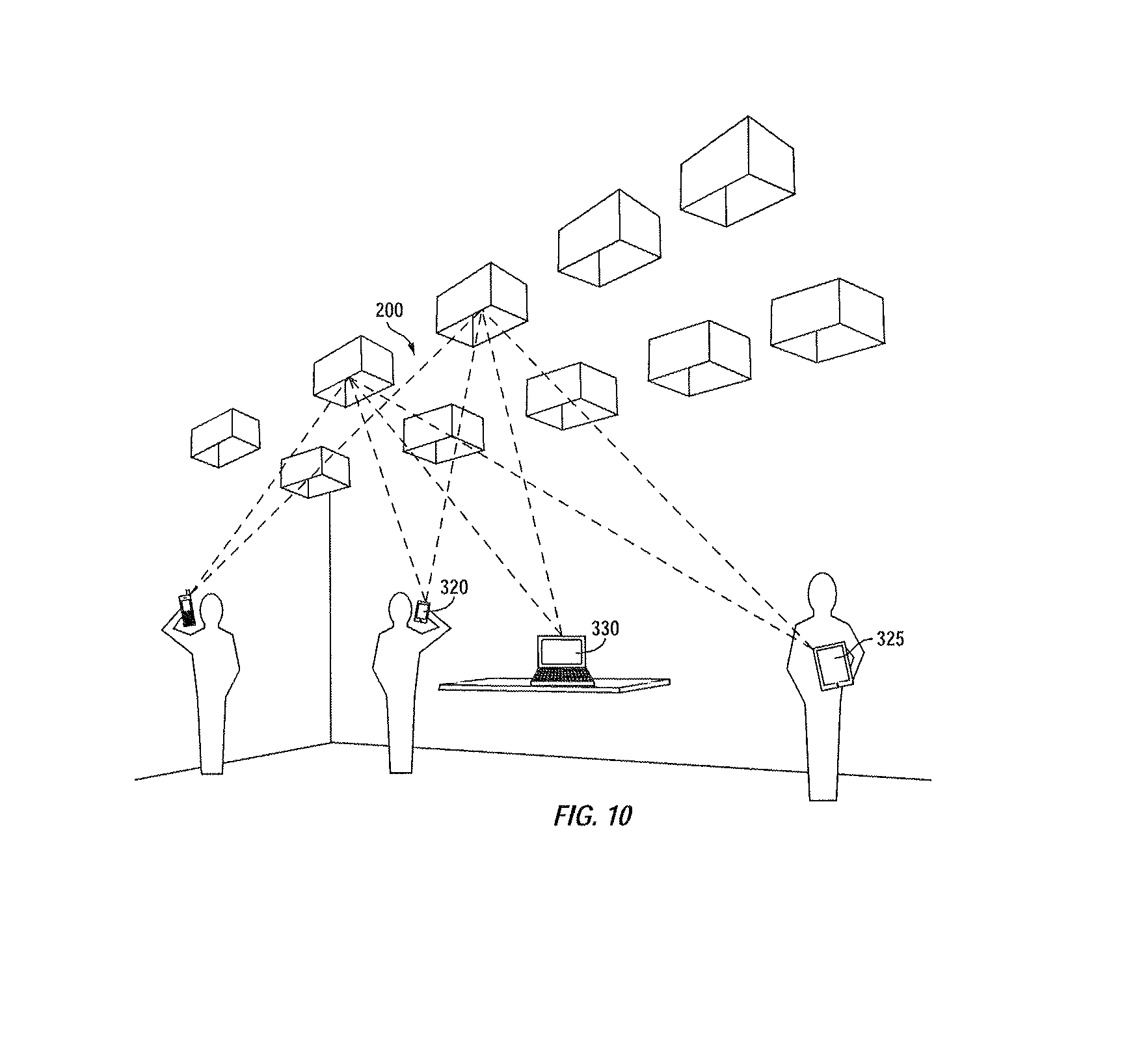

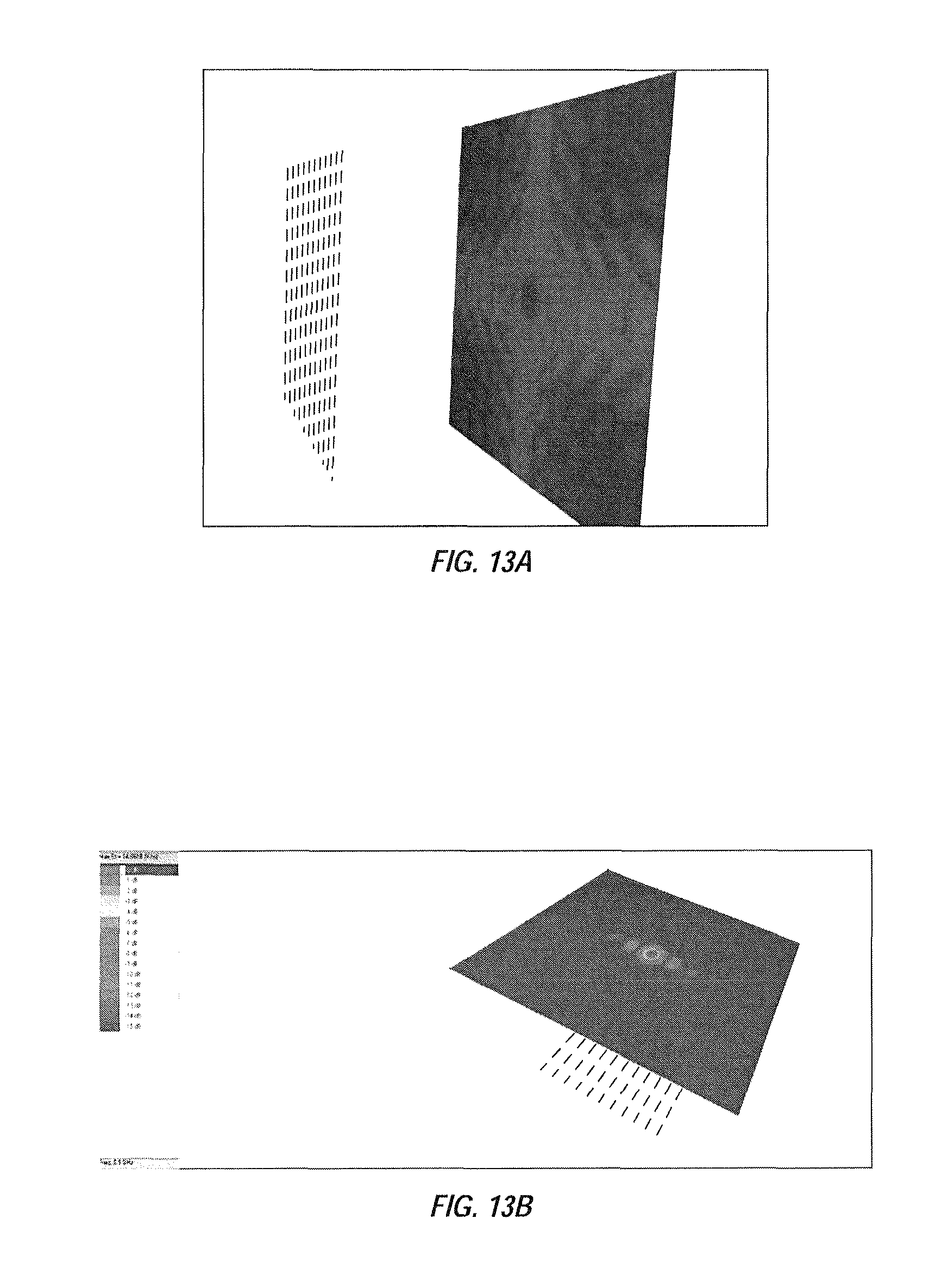


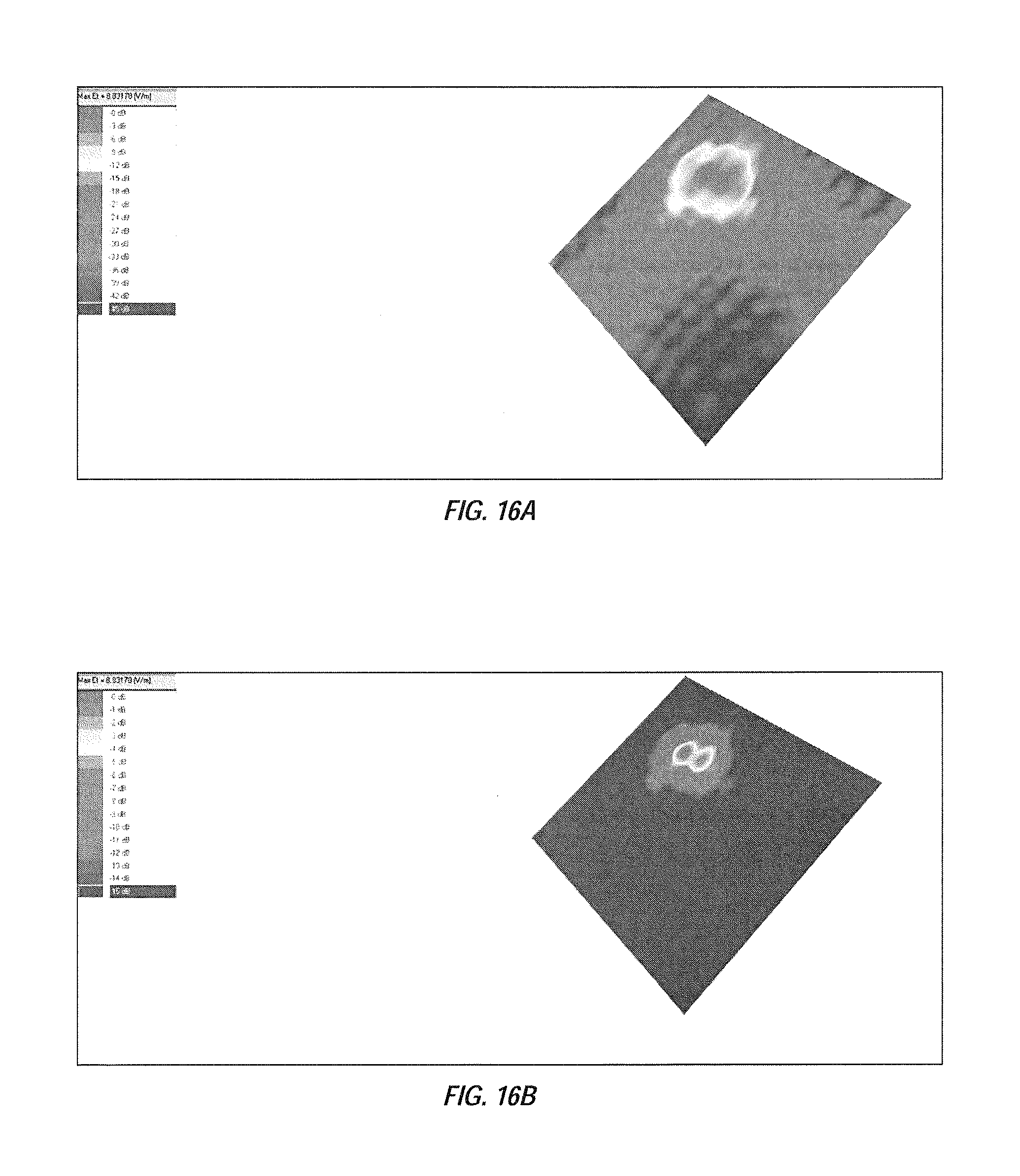
View All Diagrams
| United States Patent | 10,367,380 |
| Sengupta , et al. | July 30, 2019 |
Smart RF lensing: efficient, dynamic and mobile wireless power transfer
Abstract
An RF lens includes a multitude of radiators adapted to transmit radio frequency electromagnetic EM waves whose phases are modulated so as to concentrate the radiated power in a small volume of space in order to power an electronic device positioned in that space. Accordingly, the waves emitted by the radiators are caused to interfere constructively at that space. The multitude of radiators are optionally formed in a one-dimensional or two-dimensional array. The electromagnetic waves radiated by the radiators have the same frequency but variable amplitudes.
| Inventors: | Sengupta; Kaushik (Princeton, NJ), Hajimiri; Seyed Ali (La Canada, CA) | ||||||||||
|---|---|---|---|---|---|---|---|---|---|---|---|
| Applicant: |
|
||||||||||
| Assignee: | CALIFORNIA INSTITUTE OF
TECHNOLOGY (Pasadena, CA) |
||||||||||
| Family ID: | 50685254 | ||||||||||
| Appl. No.: | 14/078,489 | ||||||||||
| Filed: | November 12, 2013 |
Prior Publication Data
| Document Identifier | Publication Date | |
|---|---|---|
| US 20140175893 A1 | Jun 26, 2014 | |
Related U.S. Patent Documents
| Application Number | Filing Date | Patent Number | Issue Date | ||
|---|---|---|---|---|---|
| 61724638 | Nov 9, 2012 | ||||
| Current U.S. Class: | 1/1 |
| Current CPC Class: | H02J 7/025 (20130101); H02J 50/23 (20160201); H01Q 21/225 (20130101); H02J 50/90 (20160201); H02J 50/20 (20160201); H02J 50/40 (20160201); H02J 50/80 (20160201); H02J 50/402 (20200101); H02J 50/60 (20160201) |
| Current International Class: | H01Q 21/22 (20060101); H02J 50/23 (20160101); H02J 7/02 (20160101); H02J 50/80 (20160101); H02J 50/90 (20160101); H02J 50/40 (20160101) |
References Cited [Referenced By]
U.S. Patent Documents
| 1119732 | May 1907 | Tesla |
| 5400037 | March 1995 | East |
| 6127799 | October 2000 | Krishnan |
| 6184651 | February 2001 | Fernandez et al. |
| 6208287 | March 2001 | Sikina et al. |
| 6664770 | December 2003 | Bartels |
| 6946950 | September 2005 | Ueno et al. |
| 6967462 | November 2005 | Landis |
| 7027311 | April 2006 | Vanderelli et al. |
| 8284055 | October 2012 | Butler et al. |
| 8396173 | March 2013 | Ling et al. |
| 9030161 | May 2015 | Lu |
| 9124125 | September 2015 | Leabman |
| 9130397 | September 2015 | Leabman |
| 9130602 | September 2015 | Cook |
| 9173178 | October 2015 | Chakraborty |
| 2002/0030527 | March 2002 | Hung et al. |
| 2002/0090966 | July 2002 | Hansen et al. |
| 2004/0005863 | January 2004 | Carrender |
| 2004/0266338 | December 2004 | Rowitch |
| 2006/0287596 | December 2006 | Johnson et al. |
| 2007/0178945 | August 2007 | Cook et al. |
| 2007/0182367 | August 2007 | Partovi |
| 2008/0014897 | January 2008 | Cook et al. |
| 2008/0309452 | December 2008 | Zeine |
| 2009/0011734 | January 2009 | Mertens et al. |
| 2009/0261779 | October 2009 | Zyren |
| 2010/0033021 | February 2010 | Bennett |
| 2010/0034238 | February 2010 | Bennett |
| 2010/0048255 | February 2010 | Jojivet et al. |
| 2010/0142509 | June 2010 | Zhu et al. |
| 2010/0181961 | July 2010 | Novak et al. |
| 2010/0208848 | August 2010 | Zhu et al. |
| 2010/0214159 | August 2010 | Ookawa et al. |
| 2010/0259447 | October 2010 | Crouch |
| 2010/0277003 | November 2010 | Von Novak et al. |
| 2010/0309078 | December 2010 | Rofougaran et al. |
| 2010/0315045 | December 2010 | Zeine |
| 2011/0025133 | February 2011 | Sauerlaender et al. |
| 2011/0050166 | March 2011 | Cook et al. |
| 2011/0053500 | March 2011 | Menegoli et al. |
| 2011/0124310 | May 2011 | Theilmann et al. |
| 2011/0151789 | June 2011 | Viglione et al. |
| 2011/0167291 | July 2011 | Liu et al. |
| 2011/0181237 | July 2011 | Hamedi-Hagh et al. |
| 2012/0091799 | April 2012 | Rofougaran et al. |
| 2012/0126636 | May 2012 | Atsumi |
| 2012/0217111 | August 2012 | Boys et al. |
| 2012/0294054 | November 2012 | Kim et al. |
| 2012/0306284 | December 2012 | Lee et al. |
| 2012/0326660 | December 2012 | Lu et al. |
| 2013/0082651 | April 2013 | Park et al. |
| 2013/0099584 | April 2013 | Von Novak, III |
| 2013/0201003 | August 2013 | Sabesan et al. |
| 2013/0210477 | August 2013 | Peter |
| 2013/0343106 | December 2013 | Perreault et al. |
| 2014/0008993 | January 2014 | Leabman |
| 2014/0333256 | November 2014 | Widmer et al. |
| 2015/0015194 | January 2015 | Leabman et al. |
| 2015/0022147 | January 2015 | Jung |
| 2015/0130293 | May 2015 | Hajimiri et al. |
| 2015/0144701 | May 2015 | Xian et al. |
| 2015/0145350 | May 2015 | Hajimiri et al. |
| 2015/0155739 | June 2015 | Walley et al. |
| 2015/0372541 | December 2015 | Guo et al. |
| 2016/0094091 | March 2016 | Shin et al. |
| 2016/0134150 | May 2016 | Chen et al. |
| 2016/0181873 | June 2016 | Mitcheson et al. |
| 2016/0190872 | June 2016 | Bohn et al. |
| 2016/0285481 | September 2016 | Cohen |
| 2017/0111073 | April 2017 | Hajimiri et al. |
| 2017/0237469 | August 2017 | Taghivand |
| 2018/0233963 | August 2018 | Sengupta et al. |
| 2018/0233964 | August 2018 | Sengupta et al. |
| 2019/0006888 | January 2019 | Hajimiri et al. |
| 101162267 | Apr 2008 | CN | |||
| 102089952 | Jun 2011 | CN | |||
| 103748764 | Apr 2014 | CN | |||
| 2858209 | Aug 2015 | EP | |||
| 2008-245404 | Oct 2008 | JP | |||
| 2013-005529 | Dec 2011 | JP | |||
| 10-2011-0133242 | Dec 2011 | KR | |||
| 10-2011-0135507 | Dec 2011 | KR | |||
| 10-2012-0069496 | Jun 2012 | KR | |||
| WO 2007/084716 | Jul 2007 | WO | |||
| WO 2013/151259 | Oct 2013 | WO | |||
| 2014/075103 | May 2014 | WO | |||
| WO 2015/077726 | May 2015 | WO | |||
| WO 2015/077730 | May 2015 | WO | |||
| WO 2016/028939 | Feb 2016 | WO | |||
| WO 2017/053631 | Mar 2017 | WO | |||
Other References
|
International Search Report and Written Opinion for PCT Application No. PCT/US2013/069757 dated Feb. 25, 2014. cited by applicant . PCT International Search Report and Written Opinion of the International Searching Authority for application PCT/US2016/053202 dated Dec. 9, 2016. cited by applicant . Baarman, "Making Wireless Truly Wireless: The need for a universal Wireless Power Solution," Wireless Power Consortium, (Sep. 2009). [Retrieved from the Internet Jan. 9, 2017: https://www.wirelesspowerconsortium.com/technology/making-wireless-truly-- wireless.html]. cited by applicant . Dickinson, "Evaluation of a Microwave High Power Reception Conversion Array for Wireless Power Transmission," Tech. Memo. 33-41, Jet Propulsion Laboratory, California Institute of Technology, (Sep. 1, 1975). [Retrieved from the Internet Jan. 9, 2017: <https://ntrs.nasa.gov/archive/nasa/casi.ntrs.nasa.gov/19760004119.pdf- >]. cited by applicant . Dickinson, "Performance of a High-Power, 2.388-GHz Receiving Array in Wireless Power Transmission Over 1.54 km," Microwave Symposium, 1976, IEEE-MTT-S International, pp. 139-141, IEEE, (1976). cited by applicant . Hirai, et al., "Practical Study on Wireless Transmission of Power and Information for Autonomous Decentralized Manufacturing System," IEEE Transactions on Industrial Electronics, 46(2):349-359, (1999). cited by applicant . Karalis, et al., "Efficient wireless non-radiative mid-range energy transfer," Annals of Physics, 323(2008):34-38, (2008). cited by applicant . Kurs, et al., "Wireless Power Transfer via Strongly Coupled Magnetic Resonances," Science, 371(83):83-86, (2007). cited by applicant . Tong, "A Novel Differential Microstrip Patch Antenna and Array at 79 GHz," , Proc. Int. Antennas Propag. Symp., pp. 279-280, (2008). [Retrieved from the Internet Jan. 9, 2017: <https://www.researchgate.net/profile/Christoph_Wagner4/publication/22- 8992601_A_novel_differential_microstrip_patch_antenna_and_array_at_79_GHz/- lin ks/00b4952930cb62e535000000.pdf>]. cited by applicant . Whitesides, "Researchers Beam `Space` Solar Power in Hawaii," Wired Magazine, (Sep. 12, 2008). [Retrieved from the Internet Jan. 10, 2017: <https://www.wired.com/2008/09/visionary-beams/>]. cited by applicant . EP Supplementary European Search Report for application 13854148 dated Jun. 20, 2016. cited by applicant . PCT International Search report and Written Opinion of the International Searching Authority for application PCT/US2015/045969 dated Oct. 23, 2015. cited by applicant . PCT International Preliminary Report on Patentability for application PCT/US2013/069757 dated May 12, 2015. cited by applicant . PCT International Preliminary Report on Patentability for application PCT/US2014/067175 dated May 24, 2016. cited by applicant . PCT International Preliminary Report on Patentability for application PCT/US2014/067187 dated May 24, 2016. cited by applicant . PCT International Search Report and Written Opinion of the International Searching Authority for application PCT/US2014/067175 dated Mar. 16, 2015. cited by applicant . PCT International Search Report and Written Opinion of the International Searching Authority for application PCT/US2014/067187 dated Mar. 16, 2015. cited by applicant . Kotani et al., "High-Efficiency Differential-Drive CMOS Rectifier for UHF RFIDs," IEEE Journal of Solid-State Circuits, 44(11):3011-3018, (2009). cited by applicant . Moon et al., "A 3.0-W Wireless Power Receiver Circuit with 75-% Overall Efficiency," IEEE Asian Solid State Circuits Conference (A-SSCC), pp. 97-100, Nov. 12, 2012. cited by applicant . EPO Application No. EP14863147, Supplementary European Search Report completed Jun. 30, 2017. cited by applicant . EPO Application No. EP14863210, Supplementary European Search Report dated May 16, 2017. cited by applicant . PCT International Preliminary Report on Patentability for application PCT/US2015/045969 dated Feb. 21, 2017. cited by applicant . U.S. Appl. No. 14/552,249, Non-Final Office Action dated Aug. 2, 2017. cited by applicant . U.S. Appl. No. 14/552,414, Non-Final Office Action dated Mar. 24, 2017. cited by applicant . U.S. Appl. No. 14/552,414, Notice of Allowance dated Oct. 9, 2018. cited by applicant . U.S. Appl. No. 14/552,414, Response to Non-Final Office Action filed Sep. 26, 2018. cited by applicant . U.S. Appl. No. 14/830,692, Notice of Allowance dated Jun. 14, 2018. cited by applicant . EPO Application No. 15833852.5, Supplementary European Search Report and European Search Opinion dated May 18, 2018. cited by applicant . U.S. Appl. No. 14/830,692, Notice of Allowance dated May 18, 2018. cited by applicant . U.S. Appl. No. 14/830,692, Response to Non-Final Office Action filed Apr. 16, 2018. cited by applicant . U.S. Appl. No. 15/273,633, Non-Final Office Action dated Sep. 20, 2018. cited by applicant . WIPO Application No. PCT/US2016/053202, PCT International Preliminary Report on Patentability dated Mar. 27, 2018. cited by applicant . WIPO Application No. PCT/US2018/034947, PCT International Search Report and Written Opinion of the International Searching Authority dated Aug. 3, 2018. cited by applicant . U.S. Appl. No. 14/552,414, Notice of Allowance dated Feb. 12, 2019. cited by applicant . U.S. Appl. No. 15/273,633, Response to Non-Final Office Action filed Feb. 22, 2019. cited by applicant . U.S. Appl. No. 14/552,414, Non-Final Office Action dated Mar. 26, 2018. cited by applicant . U.S. Appl. No. 15/273,633, Requirement for Restriction/Election dated Mar. 28, 2018. cited by applicant . Zheng, "Introduction to Air-to-air missiles system," Weapon Industry Press, Beijing, pp. 94-95, Dec. 31, 1997. cited by applicant . U.S. Appl. No. 14/552,249, Notice of Allowance dated Feb. 22, 2018. cited by applicant . U.S. Appl. No. 14/552,249, Response to Non-Final Office Action filed Jan. 19, 2018. cited by applicant . U.S. Appl. No. 14/552,414, Final Office Action dated Oct. 26, 2017. cited by applicant . U.S. Appl. No. 14/552,414, Response to Final Office Action filed Jan. 25, 2018. cited by applicant . U.S. Appl. No. 14/552,414, Response to Non-Final Office Action filed Sep. 25, 2017. cited by applicant . U.S. Appl. No. 14/830,692, Non-Final Office Action dated Oct. 16, 2017. cited by applicant . U.S. Appl. No. 14/830,692, Requirement for Restriction/Election dated Jul. 6, 2017. cited by applicant . U.S. Appl. No. 14/830,692, Response to Requirement for Restriction/Election filed Aug. 15, 2017. cited by applicant. |
Primary Examiner: Barnie; Rexford N
Assistant Examiner: Ortiz; Elim
Attorney, Agent or Firm: Alston & Bird LLP
Parent Case Text
CROSS-REFERENCE TO RELATED APPLICATIONS
The present application claims benefit under 35 .sctn. U.S.C 119(e) of U.S. Provisional Patent Application No. 61/724,638, filed Nov. 9, 2012, entitled "Smart RF Lensing: Efficient, Dynamic And Mobile Wireless Power Transfer", the contents of which is incorporated herein by reference in its entirety.
Claims
What is claimed is:
1. An RF lens comprising: a first plurality of radiators adapted to radiate electromagnetic waves to power a device positioned away from the RF lens, wherein the plurality of radiators operate at a first frequency; and a plurality of locked loop circuits adapted to control phases of the electromagnetic waves radiated by the first plurality of radiators such that the phase of the electromagnetic wave radiated by each of the plurality of radiators is set in accordance with a distance between the radiator and the device, wherein said plurality of locked loop circuits are further adapted to lock a phase or a frequency of the electromagnetic wave radiated by each of the first plurality of radiators to a phase or frequency of a reference signal, wherein said reference signal is not generated by a target receiving the electromagnetic waves radiated by the plurality of radiators.
2. The RF lens of claim 1 wherein said first plurality of radiators are formed in an array.
3. The RF lens of claim 2 wherein said array is a one-dimensional array.
4. The RF lens of claim 2 wherein said array is a two-dimensional array.
5. The RF lens of claim 1 wherein an amplitude of an electromagnetic wave radiated by each of the first plurality of radiators is variable.
6. The RF lens of claim 1 wherein each of the first plurality of radiators comprises: a variable delay element; and an antenna.
7. The RF lens of claim 1 wherein said first plurality of radiators are formed in a first radiator tile adapted to receive a second radiator tile having disposed therein a second plurality of radiators.
8. The RF lens of claim 1 wherein said RF lens is further adapted to track a position of the device.
9. The RF lens of claim 1 wherein each of at least a first subset of the first plurality of radiators comprises a circuit for receiving an electromagnetic wave transmitted by the device thereby enabling the RF lens to determine a position of the device in accordance with a phase of the electromagnetic wave received by each of the at least first subset of the first plurality of radiators.
10. The RF lens of claim 1 wherein each of at least a first subset of the plurality of radiators comprises a circuit for receiving an electromagnetic wave transmitted by the device thereby enabling the RF lens to determine a position of the device in accordance with a travel time of the electromagnetic wave from the device to each of the at least first subset of the first plurality of radiators and a travel time of a response electromagnetic wave transmitted from the RF lens to the device.
11. The RF lens of claim 1 wherein said RF lens is formed in a semiconductor substrate.
12. The RF lens of claim 1 wherein said RF lens is formed in a flexible substrate.
13. The RF lens of claim 1 wherein the amplitude/phase of the first plurality of radiators are further selected to enable electromagnetic waves scattered off objects to power the device.
14. The RF lens of claim 1 wherein said RF lens further comprises: a second plurality of radiators adapted to radiate electromagnetic waves to power a second device, wherein each of the second plurality of radiators operates at a second frequency different than the first frequency, wherein a phase of an electromagnetic wave radiated by each of the second plurality of radiators is selected to be determined by a distance between the radiator and the second device.
15. The RF lens of claim 1 wherein each of the plurality of locked loop circuits is a phase locked loop circuit.
16. The RF lens of claim 1 wherein each of the plurality of locked loop circuits is a frequency locked loop circuit.
17. The RF lens of claim 1 wherein the first frequency is different from the frequency of the reference signal.
18. The RF lens of claim 1 wherein the frequency of the reference signal is a sub-harmonic of the first frequency.
19. The RF lens of claim 1 wherein said RF lens is further adapted to track and power a second device.
20. The RF lens of claim 1 wherein a distance between a first one of the first plurality of radiators and a second one of the first plurality of radiators is different from a distance between a third one of the first plurality of radiators and a fourth one of the first plurality of radiators.
21. A method of wirelessly powering a device, the method comprising: transmitting a plurality of electromagnetic waves at a first frequency from a first plurality of radiators to the device; varying phases of the first plurality of radiators by a plurality of locked loop circuits such that the phase of an electromagnetic wave radiated by each of the plurality of radiators is set in accordance with a distance between the radiator and the device; locking a phase or a frequency of the electromagnetic wave radiated by each of the first plurality of radiators to a phase or frequency of a reference signal, wherein said reference signal is not generated by a target receiving the electromagnetic waves radiated by the plurality of radiators; and providing power to the device using the plurality of electromagnetic waves received by the device.
22. The method of claim 21 further comprising: forming the first plurality of radiators in an array.
23. The method of claim 22 further comprising: forming the first plurality of radiators in a one-dimensional array.
24. The method of claim 22 further comprising: forming the first plurality of radiators in a two-dimensional array.
25. The method of claim 21 further comprising: varying an amplitude of an electromagnetic wave radiated by each of the first plurality of radiators.
26. The method of claim 21 wherein each of the plurality of radiators comprises: a variable delay element; and an antenna.
27. The method of claim 21 wherein said first plurality of radiators are formed in a first radiator tile adapted to receive a second radiator tile having disposed therein a second plurality of radiators.
28. The method of claim 21 further comprising: tracking a position of the device.
29. The method of claim 21 further comprising: determining a position of the device in accordance with relative phases of an electromagnetic wave transmitted by the device and received by each of a first subset of the first plurality of radiators.
30. The method of claim 21 further comprising: determining a position of the device in accordance with a travel time of an electromagnetic wave transmitted by the device and received by each of a first subset of the first plurality of radiators, and further in accordance with a travel time of a response electromagnetic wave transmitted from the RF lens to the device.
31. The method of claim 21 further comprising: forming the first plurality of radiators in a semiconductor substrate.
32. The method of claim 21 further comprising: forming the first plurality of radiators in a flexible substrate.
33. The method of claim 21 further comprising: selecting the amplitude/phase of the first plurality of radiators to enable the electromagnetic waves transmitted by the first plurality of radiators and scattered off objects to power the device.
34. The method of claim 21 further comprising: transmitting a second plurality of electromagnetic waves having a second frequency from a second plurality of radiators to a second device and concurrently with the transmission of the electromagnetic waves from the first plurality of radiators; selecting a phase of each of the second plurality of radiators in accordance with a distance between the radiator and the second device; and providing power to the second device using the second plurality of electromagnetic waves.
35. The method of claim 21 further comprising: tracking and powering a second device using the electromagnetic waves radiated by the first plurality of radiators.
36. The method of claim 21 wherein a distance between a first one of the first plurality of radiators and a second one of the first plurality of radiators is different from a distance between a third one of the first plurality of radiators and a fourth one of the first plurality of radiators.
37. The method of claim 21 wherein each of the plurality of locked loop circuits is a phase locked loop circuit.
38. The method of claim 21 wherein each of the plurality of locked loop circuits is a frequency locked loop circuits.
39. The method of claim 21 wherein the first frequency is different from the frequency of the reference signal.
40. The method of claim 21 wherein the frequency of the reference signal is a sub-harmonic of the first frequency.
Description
BACKGROUND OF THE INVENTION
The present invention relates to wireless communication, and more particularly to wireless power transfer.
BACKGROUND OF THE INVENTION
Electrical energy used in powering electronic devices comes predominantly from wired sources. Conventional wireless power transfer relies on magnetic inductive effect between two coils placed in close proximity of one another. To increase its efficiency, the coil size is selected to be less than the wavelength of the radiated electromagnetic wave. The transferred power diminishes strongly as the distance between the source and the charging device is increased.
BRIEF SUMMARY OF THE INVENTION
An RF lens, in accordance with one embodiment of the present invention, includes, in part, a multitude of radiators adapted to radiate electromagnetic waves to power a device positioned away from the RF lens. Each of the multitude of radiators operates at the same frequency. The phase of the electromagnetic wave radiated by each of the multitude of radiators is selected to be representative of the distance between that radiator and the device.
In one embodiment, the multitude of radiators are formed in an array. In one embodiment, the array is a one-dimensional array. In another embodiment, the array is a two-dimensional array. In one embodiment, the amplitudes of the electromagnetic waves radiated by the radiators is variable. In one embodiment, each of the multitude of radiators includes, in part, a variable delay element, a control circuit adapted to lock the phase or frequency of the electromagnetic wave radiated by that radiator to the phase or frequency of a reference signal, an amplifier, and an antenna.
In one embodiment, the multitude of radiators are formed in a first radiator tile adapted to receive a second radiator tile having disposed therein another multitude of radiators. In one embodiment, the RF lens is further adapted to track a position of the device. In one embodiment, each of a first subset of the radiators includes a circuit for receiving an electromagnetic wave transmitted by the device thus enabling the RF lens to determine the position of the device in accordance with the phases of the electromagnetic wave received by the first subset of the radiators.
In one embodiment, each of at least a first subset of the radiators includes a circuit for receiving an electromagnetic wave transmitted by the device thereby enabling the RF lens to determine a position of the device in accordance with a travel time of the electromagnetic wave from the device to each of the first subset of the radiators and a travel time of a response electromagnetic wave transmitted from the RF lens to the device. In one embodiment, the RF lens is formed in a semiconductor substrate.
A method of wirelessly powering a device, in accordance with one embodiment of the present invention, includes, in part, transmitting a multitude of electromagnetic waves having the same frequency from a multitude of radiators to the device, selecting a phase of each of the multitude of radiators in accordance with a distance between that radiator and the device, and charging the device using the electromagnetic waves received by the device.
In one embodiment, the method further includes, in part, forming the radiators in an array. In one embodiment, the radiators are formed in a one-dimensional array. In another embodiment, the radiators are formed in a two-dimensional array. In one embodiment, the method further includes, in part, varying the amplitude of the electromagnetic wave radiated by each of the radiators.
In one embodiment, each radiators includes, in part, a variable delay element, a controlled locked circuit adapted to lock the phase or the frequency of the electromagnetic wave radiated by the radiator to the phase or frequency of a reference signal, an amplifier, and an antenna. In one embodiment, the radiators are formed in a first radiator tile adapted to receive a second radiator tile having disposed therein another multitude of radiators.
In one embodiment, the method further includes, in part, tracking the position of the device. In one embodiment, the method further includes, in part, determining the position of the device in accordance with relative phases of an electromagnetic wave transmitted by the device and received by each of at least a subset of the radiators. In one embodiment, the method further includes, in part, determining the position of the device in accordance with a travel time of an electromagnetic wave transmitted by the device and received by each of at least a subset of the radiators, and further in accordance with a travel time of a response electromagnetic wave transmitted from the RF lens to the device. In one embodiment, the method further includes, in part, forming the RF lens in a semiconductor substrate.
BRIEF DESCRIPTION OF THE DRAWINGS
FIG. 1 shows a one-dimensional array of radiators forming an RF lens, in accordance with one embodiment of the present invention.
FIG. 2 is a side view of the RF lens of FIG. 1 wirelessly delivering power to a device at a first location, in accordance with one exemplary embodiment of the present invention.
FIG. 3 is a side view of the RF lens of FIG. 1 wirelessly delivering power to a device at a second location, in accordance with one exemplary embodiment of the present invention.
FIG. 4 is a side view of the RF lens of FIG. 1 wirelessly delivering power to a device at a third location, in accordance with one exemplary embodiment of the present invention.
FIG. 5 shows a two-dimensional array of radiators forming an RF lens, in accordance with one exemplary embodiment of the present invention.
FIG. 6A is a simplified block diagram of a radiator disposed in an RF lens, in accordance with one exemplary embodiment of the present invention.
FIG. 6B is a simplified block diagram of a radiator disposed in an RF lens, in accordance with another exemplary embodiment of the present invention.
FIG. 7 shows a number of electronic components of a device adapted to be charged wirelessly, in accordance with one exemplary embodiment of the present invention.
FIG. 8 is a schematic diagram of an RF lens wirelessly charging a device, in accordance with one exemplary embodiment of the present invention.
FIG. 9 is a schematic diagram of an RF lens concurrently charging a pair of devices, in accordance with one exemplary embodiment of the present invention.
FIG. 10 is a schematic diagram of an RF lens concurrently charging a pair of mobile devices and a stationary device, in accordance with one exemplary embodiment of the present invention.
FIG. 11A shows computer simulations of the electromagnetic field profiles of a one-dimensional RF lens, in accordance with one exemplary embodiment of the present invention.
FIG. 11B is a simplified schematic view of an RF lens used in generating the electromagnetic field profiles of FIG. 11A.
FIG. 12 shows the variations in computer simulated electromagnetic field profiles generated by the RF lens of FIG. 11B as a function of the spacing between each adjacent pair of radiators disposed therein.
FIG. 13A is an exemplary computer-simulated electromagnetic field profile of an RF lens and using a scale of -15 dB to 0 dB, in accordance with one exemplary embodiment of the present invention.
FIG. 13B shows the computer-simulated electromagnetic field profile of FIG. 13A using a scale of -45 dB to 0 dB.
FIG. 14A is an exemplary computer-simulated electromagnetic field profile of the RF lens of FIG. 13A and using a scale of -15 dB to 0 dB, in accordance with one exemplary embodiment of the present invention.
FIG. 14B shows the computer-simulated electromagnetic field profile of FIG. 14A using a scale of -45 dB to 0 dB, in accordance with one exemplary embodiment of the present invention.
FIG. 15A is an exemplary computer-simulated electromagnetic field profile of an RF lens and using a scale of -15 dB to 0 dB, in accordance with one exemplary embodiment of the present invention.
FIG. 15B shows the computer-simulated electromagnetic field profile of FIG. 15A using a scale of -45 dB to 0 dB, in accordance with one exemplary embodiment of the present invention.
FIG. 16A is an exemplary computer-simulated electromagnetic field profile of the RF lens of FIG. 15A using a scale of -15 dB to 0 dB, in accordance with one exemplary embodiment of the present invention.
FIG. 16B shows the computer-simulated electromagnetic field profile of FIG. 16A using a scale of -45 dB to 0 dB, in accordance with one exemplary embodiment of the present invention.
FIG. 17A shows an exemplary radiator tile having disposed therein four radiators, in accordance with one exemplary embodiment of the present invention.
FIG. 17B shows an RF lens formed using a multitude of the radiator tiles of FIG. 17A, in accordance with one exemplary embodiment of the present invention.
FIG. 18 is a simplified block diagram of a radiator disposed in an RF lens, in accordance with another exemplary embodiment of the present invention.
FIG. 19 shows a number of electronic components disposed in a device adapted to be charged wirelessly, in accordance with another exemplary embodiment of the present invention.
FIG. 20 shows an RF lens tracking a device using a signal transmitted by the device, in accordance with another exemplary embodiment of the present invention.
FIG. 21 shows an RF lens transferring power to a device in the presence of a multitude of scattering objects, in accordance with another exemplary embodiment of the present invention.
FIG. 22A shows an RF lens formed using a multitude of radiators arranged in a circular shape, in accordance with one embodiment of the present invention.
FIG. 22B shows an RF lens formed using a multitude of radiators arranged in an elliptical shape, in accordance with one embodiment of the present invention.
DETAILED DESCRIPTION OF THE INVENTION
An RF lens, in accordance with one embodiment of the present invention, includes a multitude of radiators adapted to transmit radio frequency electromagnetic EM waves (hereinafter alternatively referred to as EM waves, or waves) whose phases and amplitudes are modulated so as to concentrate the radiated power in a small volume of space (hereinafter alternatively referred to as focus point or target zone) in order to power an electronic device positioned in that space. Accordingly, the waves emitted by the radiators are caused to interfere constructively at the focus point. Although the description below is provided with reference to wireless power transfer, the following embodiments of the present invention may be used to transfer any other kind of information wirelessly.
FIG. 1 shows a multitude of radiators, arranged in an array 100, forming an RF lens, in accordance with one embodiment of the present invention. Array 100 is shown as including N radiators 10.sub.1, 10.sub.2, 10.sub.3 . . . 10.sub.N-1, 10.sub.N each adapted to radiate an EM wave whose amplitude and phase may be independently controlled in order to cause constructive interference of the radiated EM waves at a focus point where a device to be charged is located, where N is integer greater than 1. FIG. 2 is a side view of the array 100 when the relative phases of the waves generated by radiators 10.sub.i (i is an integer ranging from 1 to N) are selected so as to cause constructive interference between the waves to occur near region 102 where a device being wirelessly charged is positioned, i.e., the focus point. Region 102 is shown as being positioned at approximately distance d.sub.1 from center 104 of array 100. The distance between the array center and the focus point is alternatively referred to herein as the focal length. Although the following description of an RF lens is provided with reference to a one or two dimensional array of radiators, it is understood that an RF lens in accordance with the present invention may have any other arrangement of the radiators, such as a circular arrangement 1000 of radiators 202 as shown in FIG. 22A, or the elliptical arrangement 1010 of radiators 202 shown in FIG. 22B.
As seen from FIG. 2, each radiator 10.sub.i is assumed to be positioned at distance y.sub.i from center 104 of array 100. The amplitude and phase of the wave radiated by radiator 10.sub.i are assumed to be represented by A.sub.i and .theta..sub.i respectively. Assume further that the wavelength of the waves being radiated is represented by .lamda.. To cause the waves radiated by the radiators to interfere constructively in region 102 (i.e., the desired focus point), the following relationship is satisfied between various phases .theta..sub.i and distances y.sub.i:
.theta..times..pi..lamda..times..theta..times..pi..lamda..times..theta..t- imes..pi..lamda..times. ##EQU00001##
Since the phase of an RF signal may be accurately controlled, power radiated from multiple sources may be focused, in accordance with the present invention, onto a target zone where a device to be wirelessly charged is located. Furthermore, dynamic phase control enables the tracking of the device as it moves from its initial location. For example, as shown in FIG. 3, if the device moves to a different position--along the focal plane--located at a distance d.sub.2 from center point 104 of the array, in order to ensure that the target zone is also located at distance d.sub.2, the phases of the sources may be adjusted in accordance with the following relationship:
.theta..times..pi..lamda..times..theta..times..pi..lamda..times..theta..t- imes..pi..lamda..times. ##EQU00002##
Referring to FIG. 4, if the device moves to a different position away from the focal plane (e.g., to a different point along the y-axis) the radiators' phases are dynamically adjusted, as described below, so as to track and maintain the target zone focused on the device. Parameter y.sub.c represents the y-component of the device's new position, as shown in FIG. 4, from the focal plane of the array (i.e, the plane perpendicular to the y-axis and passing through center 104 of array 100).
.theta..times..pi..lamda..times..theta..times..pi..lamda..times..theta..t- imes..pi..lamda..times. ##EQU00003##
The amount of power transferred is defined by the wavelength .lamda. of the waves being radiated by the radiators, the array span or array aperture A as shown in FIG. 1, and the focal length, i.e. (.lamda.F/A).
In one embodiment, the distance between each pair of radiators is of the order of the wavelength of the signal being radiated. For example, if the frequency of the radiated wave is 2.4 GHz (i.e., the wavelength is 12.5 cm), the distance between each two radiators may be a few tenths to a few tens of the wavelengths, that may vary depending on the application.
An RF lens, in accordance with the present invention, is operative to transfer power wirelessly in both near-field and far field regions. In the optical domain, a near field region is referred to as the Fresnel region and is defined as a region in which the focal length is of the order of the aperture size. In the optical domain, a far field region is referred to as the Fraunhofer region and is defined as a region in which the focal length (F) is substantially greater than (2A.sup.2/.lamda.).
To transfer power wirelessly to a device, in accordance with the present invention, the radiator phases are selected so as to account for differences in distances between the target point and the radiators. For example, assume that the focal length d.sub.1 in FIG. 2 is of the order of the aperture size A. Therefore, since distances S.sub.1, S.sub.2, S.sub.3 . . . S.sub.N are different from one another, corresponding phases .theta..sub.1, .theta..sub.2, .theta..sub.3 . . . .theta..sub.N of radiators 10.sub.1, 10.sub.2, 10.sub.3 . . . 10.sub.N are varied so as to satisfy expression (1), described above. The size of the focus point (approximately .lamda.F/A) is relatively small for such regions because of the diffraction limited length.
A radiator array, in accordance with the present invention, is also operative to transfer power wirelessly to a target device in the far field region where the focal length is greater than (2A.sup.2/.lamda.). For such regions, the distances from the different array elements to the focus spot are assumed be to be the same. Accordingly, for such regions, S.sub.1=S.sub.2=S.sub.3 . . . =S.sub.N, and .theta..sub.1=.theta..sub.2=.theta..sub.3 . . . =.theta..sub.N. The size of the focus point is relatively larger for such regions and thus is more suitable for wireless charging of larger appliances.
FIG. 5 shows an RF lens 200, in accordance with another embodiment of the present invention. RF lens 200 is shown as including a two dimensional array of radiators 202.sub.i,j arranged along rows and columns. Although RF lens 200 is shown as including 121 radiators 202.sub.i,j disposed along 11 rows and 11 columns (integers i and j are indices ranging from 1 to 11) it is understood that an RF lens in accordance with embodiments of the present invention may have any number of radiators disposed along U rows and V columns, where U and V are integers greater one. In the following description, radiators 202.sub.i,j may be collectively or individually referred to as radiators 202.
As described further blow, the array radiators are locked to a reference frequency, which may be a sub-harmonic (n=1, 2, 3 . . . ) of the radiated frequency, or at the same frequency as the radiated frequency. The phase of the wave radiated by each radiator are controlled independently in order to enable the radiated waves to constructively interfere and concentrate their power onto a target zone within any region in space.
FIG. 6A is a simplified block diagram of a radiator 202 disposed in RF lens 200, in accordance with one embodiment of the present invention. As seen, radiator 202 is shown as including, in part, a programmable delay element (also referred to herein as phase modulator) 210, a phase/frequency locked loop 212, a power amplifier 214, and an antenna 216. Programmable delay element 210 is adapted to delay signal W.sub.2 to generate signal W.sub.3. The delay between signals W.sub.2 and W.sub.3 is determined in accordance with control signal Ctrl applied to the delay element. In one embodiment, phase/frequency locked loop 212 receives signal W.sub.1 as well as a reference clock signal having a frequency F.sub.ref to generate signal W.sub.2 whose frequency is locked to the reference frequency F.sub.ref. In another embodiment, signal W.sub.2 generated by phase/frequency locked loop 212 has a frequency defined by a multiple of the reference frequency F.sub.ref. Signal W.sub.3 is amplified by power amplifier 214 and transmitted by antenna 216. Accordingly and as described above, the phase of the signal radiated by each radiator 202 may be varied by an associated programmable delay element 210 disposed in the radiator.
FIG. 6B is a simplified block diagram of a radiator 202 disposed in RF lens 200, in accordance with another embodiment of the present invention. As seen, radiator 202 is shown as including, in part, a programmable delay element 210, a phase/frequency locked loop 212, a power amplifier 214, and an antenna 216. Programmable delay element 210 is adapted to delay the reference clock signal F.sub.ref thereby to generate a delayed reference clock signal F.sub.ref.sub._.sub.Delay. The delay between signals F.sub.ref and F.sub.ref.sub._.sub.Delay is determined in accordance with control signal Ctrl applied to the delay element 210. Signal W.sub.2 generated by phase/frequency locked loop 212 has a frequency locked to the frequency of signal F.sub.ref.sub._.sub.Delay or a multiple of the frequency of signal F.sub.ref.sub._.sub.Delay. In other embodiments (not shown), the delay element is disposed in and is part of phase/frequency locked loop 212. In yet other embodiments (not shown), the radiators may not have an amplifier.
FIG. 7 shows a number of components of a device 300 adapted to be charged wirelessly, in accordance with one embodiment of the present invention. Device 300 is shown as including, in part, an antenna 302, a rectifier 304, and a regulator 306. Antenna 302 receives the electromagnetic waves radiated by a radiator, in accordance with the present invention. Rectifier 304 is adapted to convert the received AC power to a DC power. Regulator 306 is adapted to regulate the voltage signal received from rectifier 304 and apply the regulated voltage to the device. High power transfer efficiency is obtained, in one embodiment, if the aperture area of the receiver antenna is comparable to the size of the target zone of the electromagnetic field. Since most of the radiated power is concentrated in a small volume forming the target zone, such a receiver antenna is thus optimized to ensure that most of the radiated power is utilized for charging up the device. In one embodiment, the device may be retro-fitted externally with components required for wireless charging. In another embodiment, existing circuitry present in the charging device, such as antenna, receivers, and the like, may be used to harness the power.
FIG. 8 is a schematic diagram of RF lens 200 wirelessly charging device 300. In some embodiments, RF lens 200 wirelessly charges multiple devices concurrently. FIG. 9 shows RF lens 200 concurrently charging devices 310, and 315 using focused waves of similar or different strengths. FIG. 10 shows RF lens 200 wireless charging mobile devices 320, 325 and stationary device 330 all of which are assumed to be indoor.
FIG. 11A shows computer-simulated electromagnetic field profiles generated by a one-dimensional RF lens at a distance 2 meters away from the RF lens having an array of 11 isotropic radiators. The beam profiles are generated for three different frequencies, namely 200 MHz (wavelength 150 cm), 800 MHz (wavelength 37.5 cm), and 2400 MHz (wavelength 12.50 cm). Since the distance between each pair of adjacent radiators of the RF lens is assumed to be 20 cm, the RF lens has an aperture of 2 m. Therefore, the wavelengths are of the order of aperture size and focal length of the radiator. FIG. 11B is a simplified schematic view of such an RF lens 500 having 11 radiators 505.sub.k that are spaced 20 cm apart from one another, where K is an integer ranging from 1 to 11.
Plots 510, 520 and 530 are computer simulations of the electromagnetic field profiles respectively for 200 MHz, 800 MHz, and 2400 signals radiated by radiator 500 when the relative phases of the various radiators are selected so as to account for the path differences from each of radiators 505.sub.k to the point located 2 meters away from radiator 505.sub.6 in accordance with expression (1) above. For each of these profiles, the diffraction limited focus size is of the order of the wavelengths of the radiated signal. Plots 515, 525 and 535 are computer simulations of the electromagnetic field profiles at a distance 2 meters away from the radiator array for 200 MHz, 800 MHz, and 2400 signals respectively when the phases of radiators 505.sub.k were set equal to one another.
As seen from these profiles, for the larger wavelength having a frequency of 200 MHz (i.e, plots 510, 515), because the path differences from the individual radiators to the focus point are not substantially different, the difference between profiles 510 and 515 is relatively unpronounced. However, for each of 800 MHz and 2400 MHz frequencies, the EM confinement (focus) is substantially more when the relative phases of the various radiators are selected so as to account for the path differences from the radiators 505.sub.k to the focus point than when radiator phases are set equal to one another. Although the above examples are provided with reference to operating frequencies of 200 MHz, 800 MHz, and 2400 MHz, it is understood that the embodiments of the present may be used in any other operating frequency, such as 5.8 GHz, 10 GHz, and 24 GHz.
FIG. 12 shows the variations in computer simulated electromagnetic field profiles generated by RF lens 500--at a distance of 2 meters away from the RF lens--as a function of the spacing between each adjacent pair of radiators. The RF lens is assumed to operate at a frequency of 2400 MHz. Plots 610, 620, and 630 are computer simulations of the field profiles generated respectively for radiator spacings of 5 cm, 10 cm, and 20 cm after selecting the relative phases of the various radiators to account for the path differences from various radiators 505.sub.k to the point 2 meters away from the RF lens, in accordance with expression (1) above. Plots 615, 625, and 650 are computer simulations of the field profiles generated respectively for radiator spacings of 5 cm, 10 cm, and 20 cm assuming all radiators disposed in RF lens 500 have equal phases. As is seen from these plots, as the distance between the radiators increases--thus resulting in a larger aperture size--the EM confinement also increases thereby resulting in a smaller focus point.
FIG. 13A is the computer simulation of the EM profile of an RF lens at a distance 3 meters away from an RF lens having disposed therein a two-dimensional array of Hertzian dipoles operating at a frequency of 900 MHz, such as RF lens 200 shown in FIG. 5. The spacing between the dipole radiators are assumed to be 30 cm. The relative phases of the radiators were selected so as to account for the path differences from the radiators to the focal point, assumed to be located 3 meters away from the RF lens. In other words, the relative phases of the radiators is selected to provide the RF lens with a focal length of approximately 3 meters. The scale used in generating FIG. 13A is -15 dB to 0 dB. FIG. 13B shows the EM profile of FIG. 13A using a scale of -45 dB to 0 dB.
FIG. 14A is the computer simulation of the EM profile of the RF lens of FIGS. 13A/13B at a distance 2 meters away from the focal point, i.e., 5 meters away from the RF lens. As is seen from FIG. 14A, the radiated power is diffused over a larger area compared to those shown in FIGS. 13A and 13B. The scale used in generating FIG. 14A is -15 dB to 0 dB. FIG. 14B shows the EM profile of FIG. 14A using a scale of -45 dB to 0 dB.
FIG. 15A is the computer simulation of the EM profile of an RF lens at a distance 3 meters away from the RF lens having disposed therein a two-dimensional array of Hertzian dipoles operating at a frequency of 900 MHz. The spacing between the dipole radiators are assumed to be 30 cm. The relative phases of the radiators are selected so as to account for the path differences from the radiators to the focal point, assumed to be located 3 meters away from the RF lens and at an offset of 1.5 m from the focal plane of the RF lens, i.e., the focus point has a y-coordinate of 1.5 meters from the focal plane (see FIG. 4). The scale used in generating FIG. 15A is -15 dB to 0. FIG. 15B shows the EM profile of FIG. 15A using a scale of -45 dB to 0 dB.
FIG. 16A is the computer simulation of the EM profile of the RF lens of FIGS. 15A/15B at a distance 2 meters away from the focal point, i.e., 5 meters away from the x-y plane of the RF lens. As is seen from FIG. 16A, the radiated power is diffused over a larger area compared to that shown in FIG. 15A. The scale used in generating FIG. 16A is -15 dB to 0 dB. FIG. 16B shows the EM profile of FIG. 16A using a scale of -45 dB to 0 dB. The EM profiles shown in FIGS. 13A, 13B, 14A, 14B 15A, 15B, 16A, 16B demonstrate the versatility of an RF lens, in accordance with the present invention, in focusing power at any arbitrary point in 3D space.
In accordance with one aspect of the present invention, the size of the array forming an RF lens is configurable and may be varied by using radiator tiles each of which may include one or more radiators. FIG. 17A shows an example of a radiator tile 700 having disposed therein four radiators 15.sub.11, 15.sub.12, 15.sub.21, and 15.sub.22. Although radiator tile 700 is shown as including four radiators, it is understood that a radiator tile, in accordance with one aspect of the present invention, may have fewer (e.g., one) or more than (e.g., 6) four radiators. FIG. 17B shown an RF lens 800 initially formed using 7 radiator tiles, namely radiator tiles 700.sub.11, 700.sub.12, 700.sub.13, 700.sub.21, 700.sub.22, 700.sub.31, 700.sub.31--each of which is similar to radiator tile 700 shown in FIG. 17A--and being provided with two more radiator tiles 700.sub.23 and 700.sub.33. Although not shown, it is understood that each radiator tile includes the electrical connections necessary to supply power to the radiators and deliver information from the radiators as necessary. In one embodiment, the radiators formed in the tiles are similar to radiator 202 shown in FIG. 6.
In accordance with one aspect of the present invention, the RF lens is adapted to track the position of a mobile device in order to continue the charging process as the mobile device changes position. To achieve this, in one embodiment, a subset or all of the radiators forming the RF lens include a receiver. The device being charged also includes a transmitter adapted to radiate a continuous signal during the tracking phase. By detecting the relative differences between the phases (arrival times) of such a signal by at least three different receivers formed on the RF lens, the position of the charging device is tracked.
FIG. 18 is a simplified block diagram of a radiator 902 disposed in an RF lens, such as RF lens 200 shown in FIG. 5, in accordance with one embodiment of the present invention. Radiator 902 is similar to radiator 202 shown in FIG. 6, except that radiator 902 has a receiver amplifier and phase recovery circuit 218, and a switch S.sub.1. During power transfer, switch S.sub.1 couples antenna 216 via node A to power amplifier 214 disposed in the transmit path. During tracking, switch S.sub.1 couples antenna 216 via node B to receiver amplifier and phase recovery circuit 218 disposed in the receive path to receive the signal transmitted by the device being charged.
FIG. 19 shows a number of components of a device 900 adapted to be charged wirelessly, in accordance with one embodiment of the present invention. Device 900 is similar to device 300 shown in FIG. 7, except that device 900 has a transmit amplifier 316, and a switch S.sub.2. During power transfer, switch S.sub.2 couples antenna 302 via node D to rectifier 304 disposed in receive path. During tracking, switch S.sub.2 couples antenna 302 via node C to transmit amplifier 316 to enable the transmission of a signal subsequently used by the RF lens to detect the position of device 300. FIG. 20 shows RF lens 200 tracking device 900 by receiving the signal transmitted by device 900.
In accordance with another embodiment of the present invention, a pulse based measurement technique is used to track the position of the mobile device. To achieve this, one or more radiators forming the RF lens transmit a pulse during the tracking phase. Upon receiving the pulse, the device being tracked sends a response which is received by the radiators disposed in the array. The travel time of the pulse from the RF lens to the device being tracked together with the travel times of the response pulse from the device being tracked to the RF lens is representative of the position of the device being tracked. In the presence of scatterers, the position of the device could be tracked using such estimation algorithms as maximum likelihood, or least-square, Kalman filtering, a combination of these techniques, or the like. The position of the device may also be determined and tracked using WiFi and GPS signals.
The presence of scattering objects, reflectors and absorbers may affect the RF lens' ability to focus the beam efficiently on the device undergoing wireless charging. For example, FIG. 21 shows an RF lens 950 transferring power to device 300 in the presence of a multitude of scattering objects 250. To minimize such effects, the amplitude and phase of the individual radiators of the array may be varied to increase power transfer efficiency. Any one of a number of techniques may be used to vary the amplitude or phase of the individual radiators.
In accordance with one such technique, to minimize the effect of scattering, a signal is transmitted by one or more of the radiators disposed in the RF lens. The signal(s) radiated from the RF lens is scattered by the scattering objects and received by the radiators (see FIG. 18). An inverse scattering algorithm is then used to construct the scattering behavior of the environment. Such a construction may be performed periodically to account for any changes that may occur with time. In accordance with another technique, a portion or the entire radiator array may be used to electronically beam-scan the surroundings to construct the scattering behavior from the received waves. In accordance with yet another technique, the device undergoing wireless charging is adapted to periodically send information about the power it receives to the radiator. An optimization algorithm then uses the received information to account for scattering so as to maximize the power transfer efficiency.
In some embodiments, the amplitude/phase of the radiators or the orientation of the RF lens may be adjusted to take advantage of the scattering media. This enable the scattering objects to have the proper phase, amplitude and polarization in order to be used as secondary sources of radiation directing their power towards the device to increase the power transfer efficiency.
The above embodiments of the present invention are illustrative and not limitative. Embodiments of the present invention are not limited by number of radiators disposed in an RF lens, nor are they limited by the number of dimensions of an array used in forming the RF lens. Embodiments of the present invention are not limited by the type of radiator, its frequency of operation, and the like. Embodiments of the present invention are not limited by the type of device that may be wirelessly charged. Embodiments of the present invention are not limited by the type of substrate, semiconductor, flexible or otherwise, in which various components of the radiator may be formed. Other additions, subtractions or modifications are obvious in view of the present disclosure and are intended to fall within the scope of the appended claims
* * * * *
References
-
wirelesspowerconsortium.com/technology/making-wireless-truly-wireless.html
-
ntrs.nasa.gov/archive/nasa/casi.ntrs.nasa.gov/19760004119.pdf
-
researchgate.net/profile/Christoph_Wagner4/publication/228992601_A_novel_differential_microstrip_patch_antenna_and_array_at_79_GHz/links/00b4952930cb62e535000000.pdf
-
wired.com/2008/09/visionary-beams
D00000

D00001

D00002

D00003

D00004

D00005

D00006

D00007

D00008

D00009

D00010

D00011

D00012
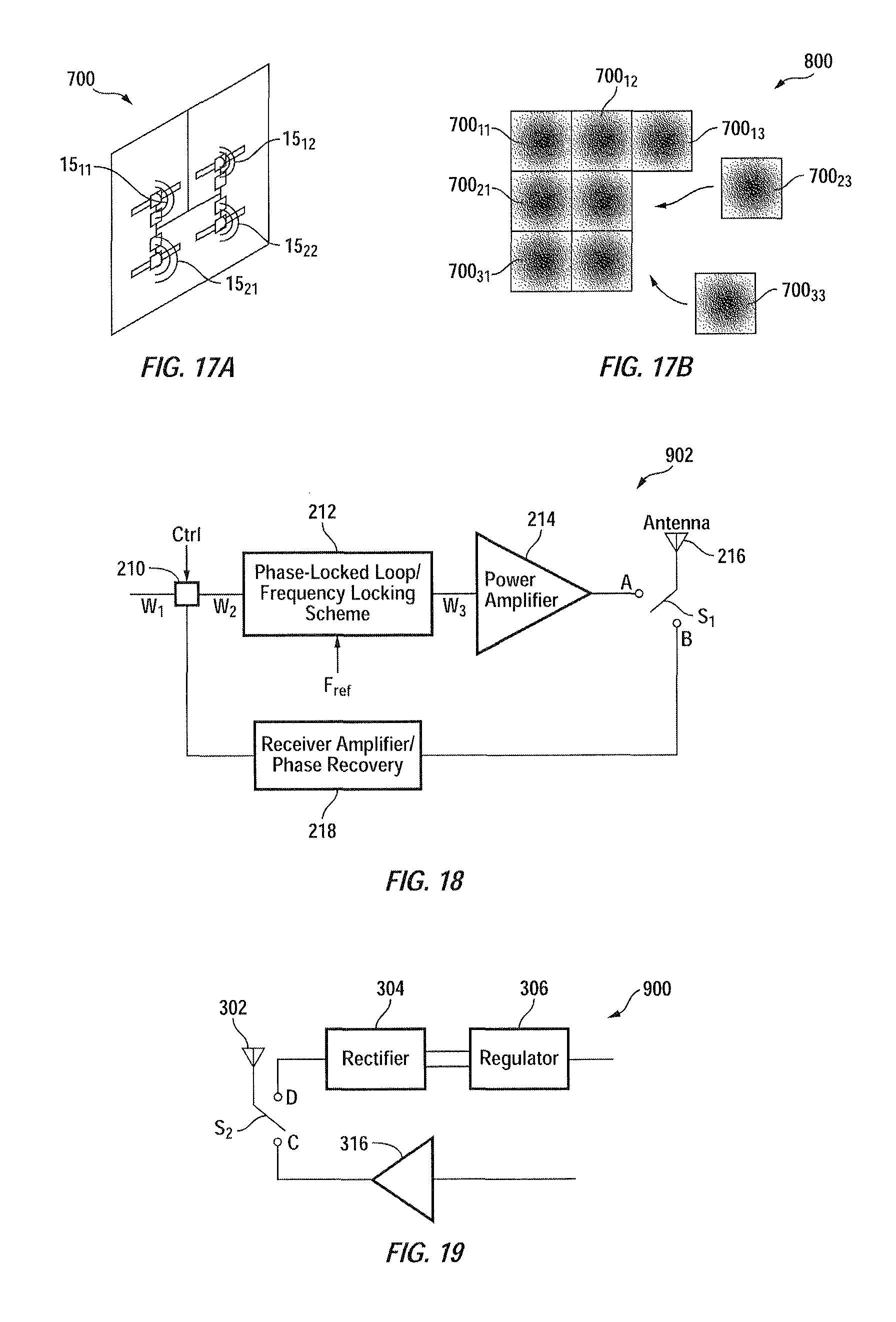
D00013
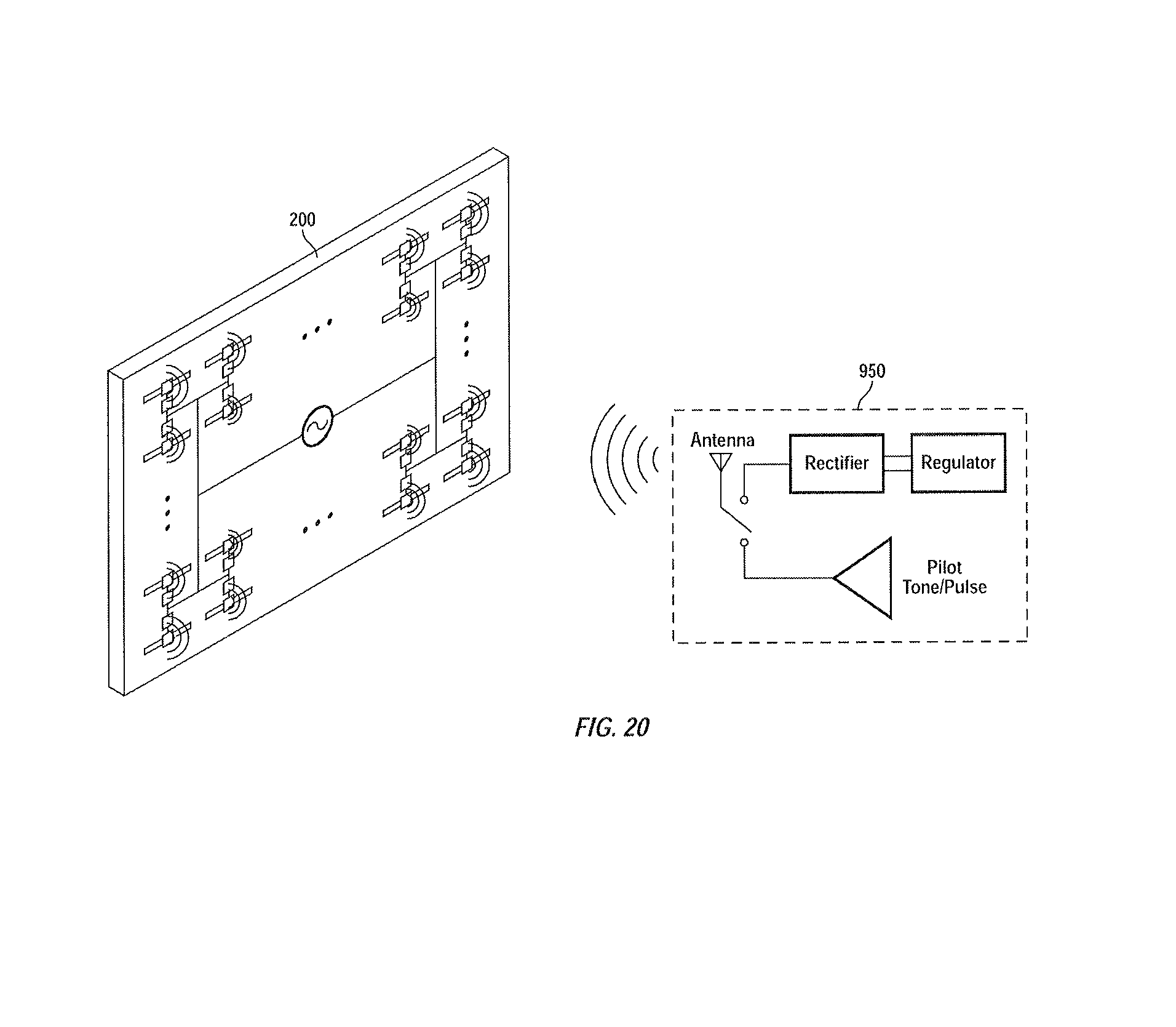
D00014
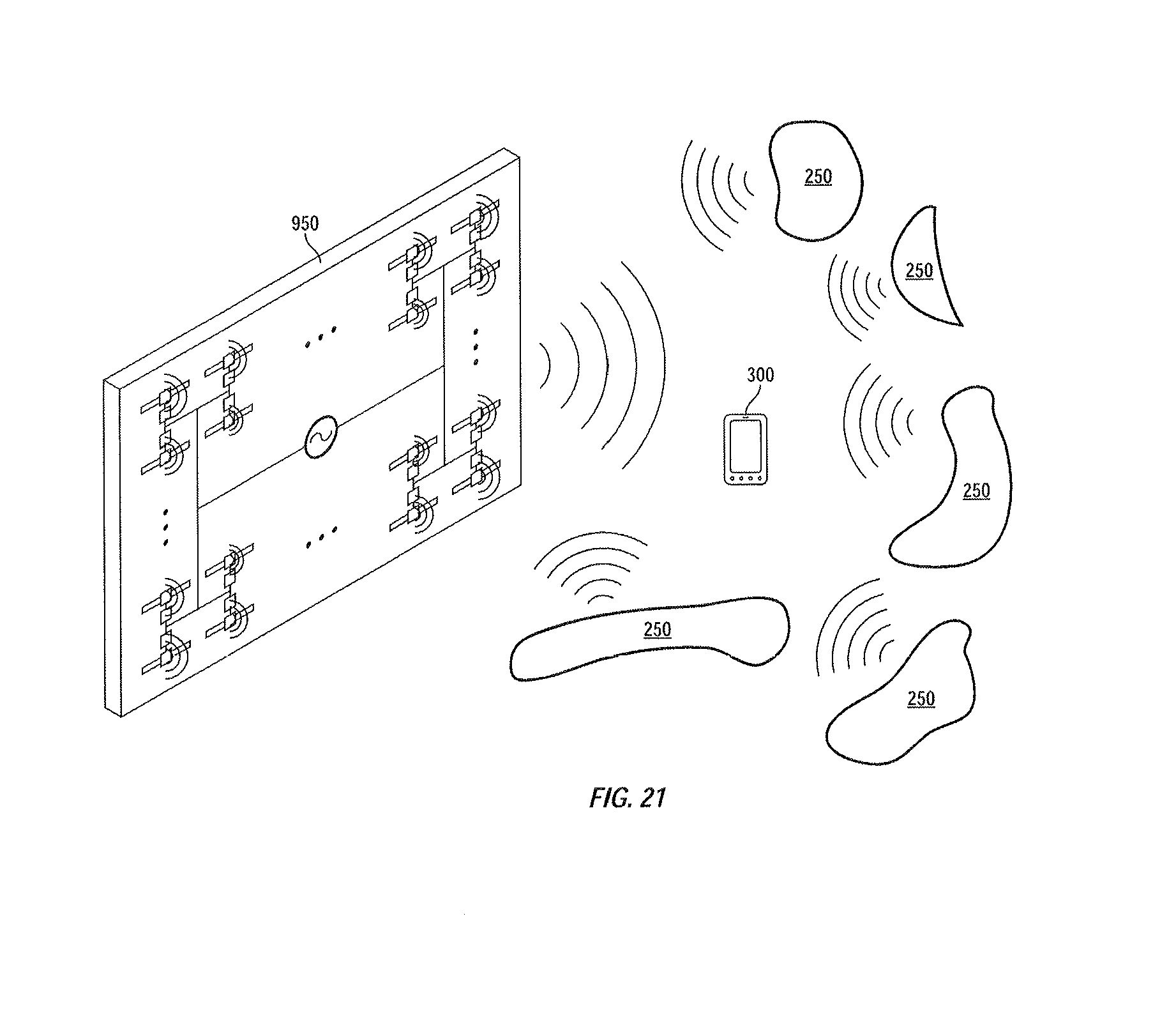
D00015
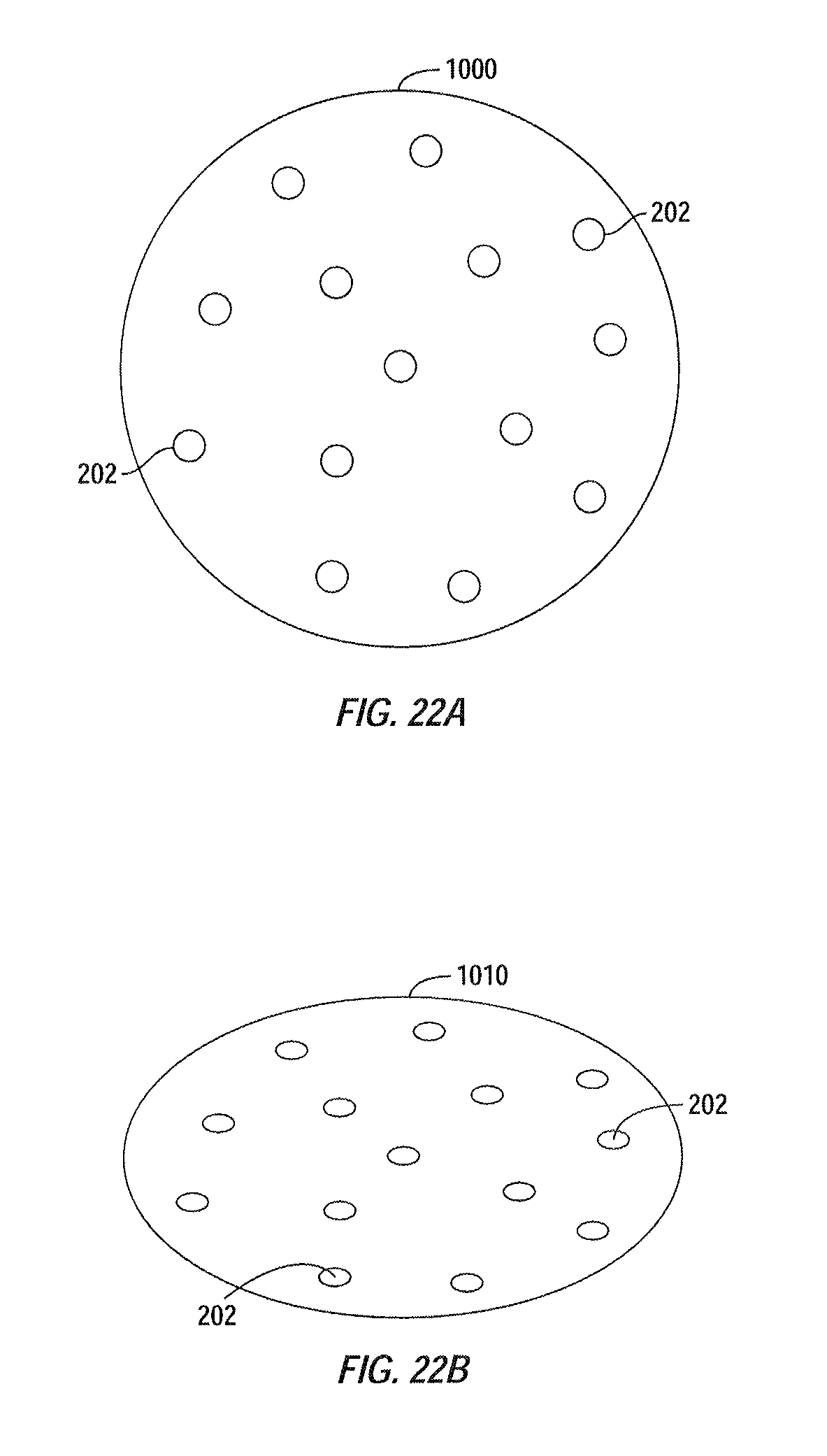
M00001

M00002

M00003

XML
uspto.report is an independent third-party trademark research tool that is not affiliated, endorsed, or sponsored by the United States Patent and Trademark Office (USPTO) or any other governmental organization. The information provided by uspto.report is based on publicly available data at the time of writing and is intended for informational purposes only.
While we strive to provide accurate and up-to-date information, we do not guarantee the accuracy, completeness, reliability, or suitability of the information displayed on this site. The use of this site is at your own risk. Any reliance you place on such information is therefore strictly at your own risk.
All official trademark data, including owner information, should be verified by visiting the official USPTO website at www.uspto.gov. This site is not intended to replace professional legal advice and should not be used as a substitute for consulting with a legal professional who is knowledgeable about trademark law.